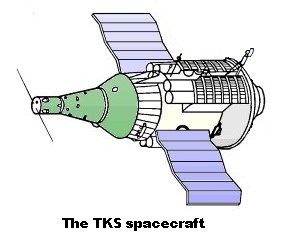 TKS
- the Transport Ship
TKS
- the Transport Ship TKS
- the Transport Ship
TKS
- the Transport ShipThe TKS consisted of two major parts: The return apparatus (VA) and the Functional Cargo Block (FGB). The FGB had two diameters, just like Almaz; 2.9 meters and 4.15 meters. However, only a small portion of the length, near the launch vehicle interface had the the wide diameter. The rest of the craft used the smaller diameter. The VA was mounted on the front end of the 2.9 meter section of the hull. Two large rocket engines were placed on each side of the hull at the front of the FGB with their thrust pointing forward. The thrust of each engine was 4385 N. Cylindrical tanks on the outside of the 2.9 meter section of the hull provided 3822 kg of propellant for these engines (1).
In development of TKS the central office of OKB-52 (now NPO Mashinostroyeniya) was responsible for the VA recovery capsule, while its Branch #1in Fili (now known as KB Salyut and part of the Khrunichev enterprise) was responsible for the baseline TKS and its FGB service systems.
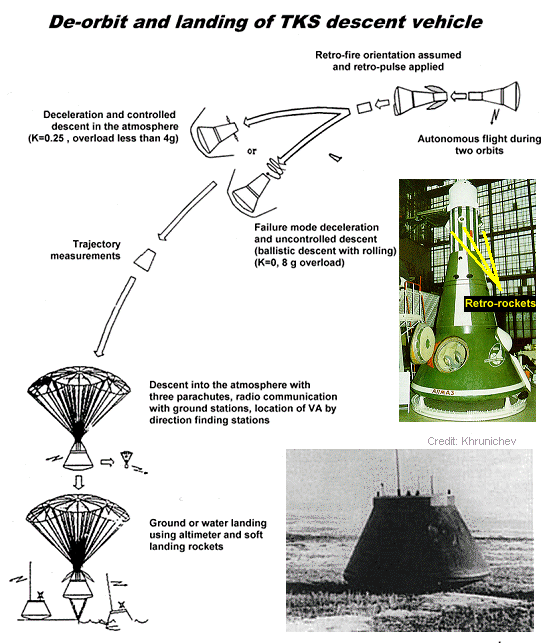 The
return apparatus (VA) for both the station and the TKS had an access
hatch
through the heat shield. The VA shape was quite similar to that
of
the Apollo CSM. The size of the VA upon touchdown was 3.05 m at the
base
of the 2.06 m high truncated cone that formed the VA (2).
At launch and in orbit there was a double cone tower-shaped structure
on
top of the landing capsule. The upper part of this tower contained
launch
escape rcokets and retro rockets for descent. The lower part probably
contained
the parachute and other equipment.
The
return apparatus (VA) for both the station and the TKS had an access
hatch
through the heat shield. The VA shape was quite similar to that
of
the Apollo CSM. The size of the VA upon touchdown was 3.05 m at the
base
of the 2.06 m high truncated cone that formed the VA (2).
At launch and in orbit there was a double cone tower-shaped structure
on
top of the landing capsule. The upper part of this tower contained
launch
escape rcokets and retro rockets for descent. The lower part probably
contained
the parachute and other equipment.
The VA was capable of
31
hours of autonomous flight
(1), but according
to the Russian sketch below the normal procedure was for the VA two fly
for two orbits separate from the Almaz base block or the TKS. The
figure
below shows how the VA would be oriented for retro fire and that some
kind
of equipment pod at the base of the capsule was separated after
retrofire.
A lifting re-entry was the normal descent mode, but if that failed the
capsule would be spin-stabilised and re-enter ballistically. After
re-entry,
the cone on top of the landing capsule detached. Some kind of simple
altimeter
(probably using the same gamma-ray detector that is used on Soyuz)
triggered
retrorockets in the upper part of the capsule to achieve a soft
landing.
A touchdown on ground or in water was possible. At landing the capsule
weighed 3800 kg (1).
In 1977-1984 four TKS vehicles were launched
| Designation | Launch date | Name | Remarks |
| TKS Mockup | 1976 Dec 15 | With Kosmos-881/882, LVI-1 | VAs: 009A/1 and 009/1 |
| TKS No. 161-01 | 1977 July 17 | Kosmos-929 | TKS test flight, VA no. 009A/2 |
| TKS Mockup | 1977 Aug 5 | LVI-2 Launch failure | VAs: 009A/P and 009/P |
| TKS Mockup | 1978 Mar 30 | With Kosmos-997/998, LVI-3 | VAs: 009A/P2 and 009P/2 (identical to 009A/2) |
| TKS Mockup | 1979 May 22 | With Kosmos-1100/1101, LVI-4 | VAs: 0102A and 0102, destroyed on landing |
| TKS No. 163-01 | 1981 Apr 25 | Kosmos-1267 | Docked with Salyut-6, VA 0103/3 |
| TKS No. 164-01 | 1983 Mar 2 | Kosmos-1443 | Docked with Salyut-7, VA 0103/1 |
| TKS-M No. 165-01 | 1985 Sep 27 | Kosmos-1686 | Docked with Salyut-7, no VA |
| FSB No. 166-01 | 1987 Mar 31 | Propulsion unit for Kvant | |
| FSB No. 162-01 | 1987 May 15 | Propulsion unit for Polyus | |
| TsM-D No. 171-01 | 1989 Nov 26 | Kvant-2 | Docked with Mir |
| TsM-T No. 172-01 | 1990 May 31 | Kristall | Docked with Mir |
| TsM-O No. 173-01 | 1995 May 20 | Spektr | Docked with Mir |
| TsM-I No. 174-01 | 1996 Apr 23 | Priroda | Docked with Mir |
| FGB No. 175-01 | 1998 Nov 20 | Zarya | ISS first element |
| USM No. 176-01 | Under construction as ISS docking module |
"... it was high tide and the force 7-8 gale and some waves were washing right over the breakwater...we returned to the van via Crooklets [beach] for an early night. But it was not to be! On arriving back Susan Colwill [the operator of the caravan park] brought me a telephone message from David Muggleton which had arrived shortly before. It said: SALYUT 19.950 APPROX. AOS 1030 1200 1330 CA 1507 RAPID DOPPLER CA 1640 RAPID DOPPLER AOS 1809 DAVID. Now what was all this about? If GMT, these times did not fit Salyut 5. .... I listened to Radio Moscow at 2000 Z and right at the end they announced Cosmos 929 but without heights......"
Yes, David Muggleton had indeed picked up Kosmos-929, which had been launched at 0900 UT, i.e. David picked up the craft one orbit after launch on the first pass over Russia. Incredible!
It later turned out that the frequency was 19.954 MHz and that there were two independent telemetry transmitter, but telemetry values in the two systems were quite similar. The most significant change was in word 14 of the 15-word telemetry frame. Word 3 and 4 in the two formats changed in the same manner. The change in frequency took place at exactly 30 minute intervals. The two format could be distinguished by the number of synchronization pulses in the frame. One had 29 pulses and the other had 30 synchronization pulses. (Read more here about the TKS shortwave telemetry systems).
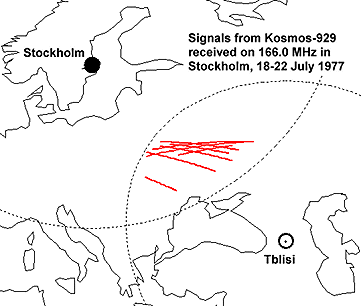 A
day after launch I also detected strong PPM-AM telemetry on 166.0 MHz
similar
to that received from Soyuz spacecraft at the time. Interestingly the
166
MHz signals were very strong but always quite brief, only 1-2 minutes
each
time. This was caused by the transmitter being turned on quite far to
the
east, just before setting below my horizon. This could of course mean
that
the command station for this transmitter was quite far to the east. The
figure on the right points to Tblisi being the command station.
Signals on this frequency were very consistent during the first month.
We certainly realized that something radical happened in mid August.
The
PPM-AM signals on 166.0 MHz ceased sometime between 16 August and 20
August.
On 18 August, Geoff Perry wrote in his day-to-day log:
A
day after launch I also detected strong PPM-AM telemetry on 166.0 MHz
similar
to that received from Soyuz spacecraft at the time. Interestingly the
166
MHz signals were very strong but always quite brief, only 1-2 minutes
each
time. This was caused by the transmitter being turned on quite far to
the
east, just before setting below my horizon. This could of course mean
that
the command station for this transmitter was quite far to the east. The
figure on the right points to Tblisi being the command station.
Signals on this frequency were very consistent during the first month.
We certainly realized that something radical happened in mid August.
The
PPM-AM signals on 166.0 MHz ceased sometime between 16 August and 20
August.
On 18 August, Geoff Perry wrote in his day-to-day log:
".....Alarm clock set so I could monitor C.929 on rev 513 at 0239 Z. Seemed to be a bit late. Has it been raised?..."The orbit was indeed raised on 17 August and we now know that the VA capsule was recovered at ... on .... . Therefore the signals on 166.0 MHz were clearly related to the recovery of the VA. So, supposedly this transmitter relayed the status of the VA. This frequency was never used again on TKS flights. But, we now know that Kosmos-929 was the only fully equipped TKS capable of carrying a crew.
The Kettering Group was indeed baffled by this flight. This is what I wrote in a note to Richard Flagg dated 10 September 1977:
"....we have had deep mysteries before. Remember how baffled we were over the Salyut-2/Cosmos-557 relationship? Eventually we will solve this riddle also......"Of course, four years later we discovered that Kosmos-929 also transmitted on 247 MHz, a characteristic of all TKS-type flights. We made this discovery just in time for the next flight of the TKS, Kosmos-1267.
The picture below shows
the
orbital history of Kosmos-929. The day when the VA detached (30 days
after
launch) is marked.
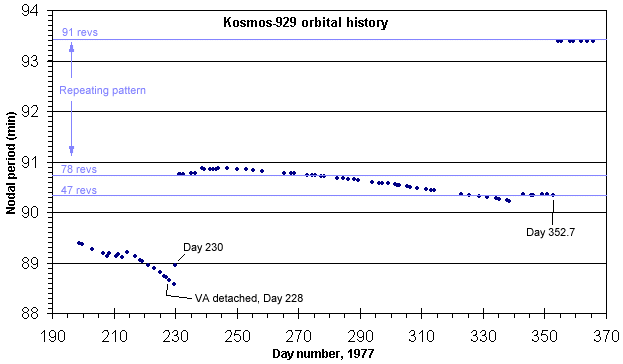
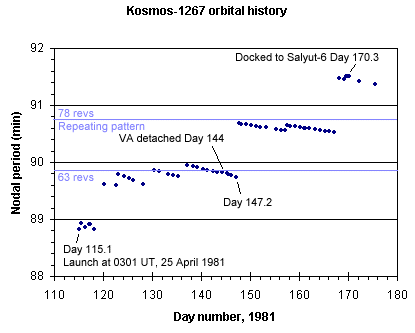 When
Kosmos-1267 was launched, the Kettering Group immediately identified it
as another "Kosmos-929"-type mission.
When
Kosmos-1267 was launched, the Kettering Group immediately identified it
as another "Kosmos-929"-type mission.
Thus, on 25 April 1981, Jan-Ola Dahlberg in Malmö picked up telemetry at 0940 UT on 19.954 MHz, 12 hours before TASS announced the flight. Since the launch took place at 0201 UT (3), Jan-Ola had picked up the signals on the fifth orbit. Remarkable! Dick Flagg in Florida also received shortwave telemetry on launch day. We also discovered a second frequency, 19.942 MHz being used by this spacecraft. Short-wave telemetry from Kosmos-1267 was similar, but certainly not identical to that from Kosmos-929 (see story on TKS shortwave telemetry).
On the first day we also realized that the orbital plane of Kosmos-1267 was about ten degrees from that of Salyut-6 and that they would come together in roughly a month's time. They would have done so if the orbit of Kosmos-1267 had not been raised.
The following day I was able to pick up telemetry on 247 MHz, confirming the discovery of signals on this frequency from Kosmos-929 (see story "Tracking satellites with a solar radiospectrograph" at this web site). These signals were also picked up occasionally by Dick Flagg in Florida, indicating the presence of a tracking ship in the vicinity.
Within ten of launch Kosmos-1267 had maneuvered up to an orbit with a period corresponding to a 63-rev repeating pattern. As far as I can ascertain the VA was detached from the FGB on day 144 (May 24, 1981), the 29 th day of flight (the Kosmos-929 VA detached after 30 days), and was recovered around 1440 UT that day. The FGB, remaining in orbit, maneuvered to an orbit with a 78-rev repeating pattern almost exactly 32.5 days after launch - just like Kosmos-929!
When the orbit of Kosmos-1267 was raised the rate of approach between the orbital planes of this craft and Salyut-6 decreased somewhat and a straight-line extrapolation showed that the orbits would be co-planar on day 169 or 170, i.e. 18 or 19 June 1981(see figure on the right). We just had to wait and see.
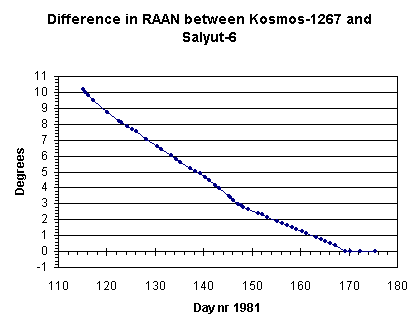 Early
in the morning of 19 June 1981 I watched as telemetry signals from
Salyut-6
(192.0 MHz) and Kosmos-1267 (247.0 MHz) seemed to disappear below
my radio horizon within 20 seconds from each other. Obviously the craft
were extremely close when I lost Kosmos-1267 at 0650.42 UT. The
shortwave
transmitter on 19.954 MHz on Kosmos-1267 was swicthed off abruptly at
0646.56
UT, something that I had not heard happening at any time earlier during
the flight.
Early
in the morning of 19 June 1981 I watched as telemetry signals from
Salyut-6
(192.0 MHz) and Kosmos-1267 (247.0 MHz) seemed to disappear below
my radio horizon within 20 seconds from each other. Obviously the craft
were extremely close when I lost Kosmos-1267 at 0650.42 UT. The
shortwave
transmitter on 19.954 MHz on Kosmos-1267 was swicthed off abruptly at
0646.56
UT, something that I had not heard happening at any time earlier during
the flight.
On the next rev I could not detect any difference in reception times. Actually the docking had taken place at 0652 UT, just after I lost the signals on the first pass that morning. TASS announced the docking at 0930 UT!.
After the docking had occurred, TASS lifted part of the veil around Kosmos-1267 and issued an intriguing, but somewhat vague statement about its mission and characteristics:
"The Soviet Union has started a new space experiment. An earth satellite of the Kosmos series has been docked with the Salyut-6 orbital station now operating in the automatic mode. The Kosmos satellite has a mass more than double that of a Soyuz spacecraft in which cosmonauts have been making their flights. The experiment is being conducted under the program to establish big space complexes. The satellite has delivered propellant needed for maneuvers by the station. The Salyut-6 orbital station has now been in orbit for nearly four years. Over thirty manned and unmanned spacecraft have docked with it."
This was indeed interesting at the time. It implied that the craft that had docked with Salyut-6 weighed in excess of 13000 kg, agreeing rather well with the figure 13266 kg for the FGB mass (1).
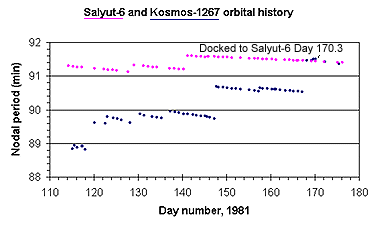 Interestingly,
at the end of June 1981, according to UPI, Konstantin Feoktistov,
cosmonaut
and spacecraft designer, had remarked that
Interestingly,
at the end of June 1981, according to UPI, Konstantin Feoktistov,
cosmonaut
and spacecraft designer, had remarked that
"Kosmos-1267 was a prototype for future Soviet space modules" (5).At this time the choice away from the Kvant-type modules, the 37K-series, where and FGB would work as a tug to bring a separate module to a station to the 77K concept eventually selected for Mir in which the FGB tug and the payload were integrated in one system had not yet occurred (4). So, what did Feoktistov refer to? The upcoming Kosmos-1686 mission or the FGB tug for Kvant and other modules on the drawing boards? Hard to say. During June 1981, amomentous event had occurred; the branch of Chelomei's design bureau (Fili branch) that ahd designed the main part of the TKS, the FBG, had just been wrested from Chelomey and put into the hands of what is now known as NPO Energiya, Feoktistov's employer!
Last signals on 247 MHz
were
received by me on 3 October 1981, around the time when Kosmos-1267
performed
the last engine firing to test the structural integrity of the orbital
complex. The last signals on 19.954 MHz were received by me on 20 May
1982,
two months before the decay of the Kosmos-1267/Salyut-6 complex on 29
July
1982. However, I must admit that I did pay scant attention to
Kosmos-1267
during the spring and summer of 1982, since Salyut-7 had just been
launched
and took most of the attention of amateur space trackers.
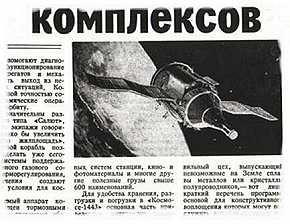 In
mid 1982 the decision was taken never to put crews in TKS's and the
remaining
craft would be used in conjunction with Salyut-7, a product of NPO
Energiya
(3).
in early 1982 the third TKS was prepared for launch. The launch escape
tower had been removed and the crew seats had been removed to make room
for cargo. The last TKS with a VA return capsule, Kosmos-1443, was
launched
at 0937:08 UT on 2 March 1983.
In
mid 1982 the decision was taken never to put crews in TKS's and the
remaining
craft would be used in conjunction with Salyut-7, a product of NPO
Energiya
(3).
in early 1982 the third TKS was prepared for launch. The launch escape
tower had been removed and the crew seats had been removed to make room
for cargo. The last TKS with a VA return capsule, Kosmos-1443, was
launched
at 0937:08 UT on 2 March 1983.
TASS announced the flight at mid-day UT and the announcement said that the craft would perform a joint flight with Salyut-7. Geoff Perry in Kettering picked up short-wave telemetry on 19.954 MHz at 1532:20 UT. This craft also had only a single telemetry mode on shortwaves. It showed some similarities to that Mode B of Kosmos-1267. The initial orbit was 1.25 degrees from the orbital plane of Salyut-7 and the orbital planes would have merged on 6 March if no maneuver was made.
On 6 March radio observations showed that the orbital period had been raised the day before to a value near 90.4 minutes. It was then obvious that the orbital planes would merge on 10 March. And, indeed, around 1000 UT on 10 March , TASS announced that the docking occurred at 0920 UT. At docking short-wave telemetry ceased, but was was resumed on 11 March. On 3 July 1983, Pravda published a sketch of Kosmos-1443 (see picture above right). This was a great event at the time. Seven years after the appearance (Kosmos-929) of what we now know was the TKS, we finally knew what it looked like.
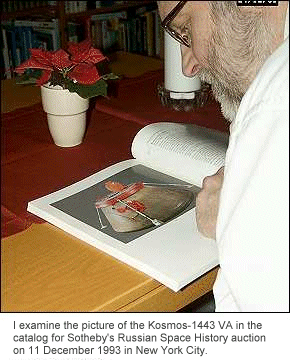 What
we did not realize was that this was not the start of something new -
that
vehicles just like this would serve future space stations - but rather
the end of a story. In the Soviet logic, they could reveal the
appearance
of a space system when there was something more modern in development.
This was the case when Vostok was revealed (Soyuz was in development).
We should have realized this in 1983 and understood that Kosmos-1443
was
the end of a line - the complete TKS.
What
we did not realize was that this was not the start of something new -
that
vehicles just like this would serve future space stations - but rather
the end of a story. In the Soviet logic, they could reveal the
appearance
of a space system when there was something more modern in development.
This was the case when Vostok was revealed (Soyuz was in development).
We should have realized this in 1983 and understood that Kosmos-1443
was
the end of a line - the complete TKS.
On 13 August I had a phone call from Dick Flagg who said he had heard that Kosmos-1443 would undock from Salyut-7 and land "next week". In the morning broadcast in English from radio Moscow on 15 August 1983 it was announced that
"The Soviet cargo spaceship, Kosmos.1443, has separated from the station, Salyut, and is returning to Earth. ....test were made of onboard systems, units, and structural elements of future spacecraft and exercises were held inmanaging large space comlexes."
The undocking occured at 1404 UT on 14 August. The VA crew return vehicle finally landed with 317 kg of cargo at 1302 UT on 23 August 1983 (3).. As described elsewhere (3) this capsule was sold to the Perot Foundation at the Sotheby's auction on 11 December 1993 in New York City (see picture on the right). It is displayed at the National Air & Space Museum in Washington D.C.
TKS-M, a.k.a. Kosmos-1686, was launched at 0841:42 UT on 27 September 1985. This craft did not have a functional VA, but instead an extensive set of instruments for military tests in space. Indeed, at this time the decision to develop add-on modules to Mir based on the FGB service part of the TKS had been taken (4). Kosmos-1686 can therefore be regarded as a prototype for later add-on modules to Mir. However it still carried subsystems very similar to those of the original TKS vehicle. Thus, telemetry was again received on 19.954 MHz and 247.475 MHz (see article on TKS HF telemetry). Kosmos-1686 docked with Salyut-7 on 2 October 1985. The resident crew on the space station had been launched to Salyut-7 just ten days before Kosmos-1686. The resident crew consisted of Vasyutin, Savinykh and Volkov - a "military" crew.
The Kettering Group received normal telemetry and voice from the crew during October and most of November 1985. However, at 1909.05-1913.40 UT on 13 November 1985 I picked up scrambled voice (listen to 13 Nov 1985 recording here) (of the same type as that received from Salyut-6) indicating that something confidential was discussed, probably a medical problem. The Kettering Group received more scrambled voice in the days to follow (16 and 17 November). Interestingly, the 20.008 MHz telemetry transmitter also began to be heard at this time, indicating that the status of the return ship was of great interest. It was therfore not entirely surprising when the crew landed at 1031 UT on 21 November because Vasyutin was ill. Reportedly he had a high fever (40 C, 104 F) and suffered from an inflammation of some sort (6).
This was evidently a
setback
for the intended mission of Kosmos-1686 and another visit to Salyut-7
to
finish the work with the TKS-M was carried out in 1986 by the Soyuz
T-15
crew in connection with its fascinating and unique
expedition from Mir to Salyut-7 and back again to Mir.
Cosmonauts
Kizim and Solovyev stayed on Salyut-7 from 6 may until 25 June. This
was
the last time Salyut-7 was manned. It seems that there were plans to
visit
again, but these had to be abandoned when the orientation system of
Kosmos-1686
failed in December 1989. Salyut-7 with Kosmos-1686 decayed from orbit
on
7 February 1991. I received the last transmission from Kosmos-1686 on
19.954
MHz on 27 November 1989.
14 and 19 July
1976
There were signals on
19.944
MHz with the same telemetry format type but with different word values
compared to Salyut-5 but transmitted overlapping with Salyut-5 on the
same
frequency. For example: on 19 July Salyut-5 transmitted 1122-1144 UT
while
the ground based signal was on between 1138-1211 UT! Very strange!
1, 2, and 4
August
1987
A signal was present on
19.955 MHz with the same telemetry format type but with different word
values compared to Kosmos-1686. the transmissions from the ground did
not
overlap with those from Kosmos-1686 in time or in frequency, because
Kosmos-1686
was on 19.954 MHz (which is indeed very close in frequency).
What were these
ground-based
signals? Simulators of OPS and TKS up and running while the ships were
in orbit?